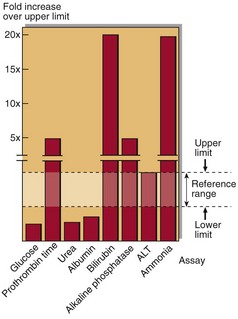Liver disease
Investigation
Outcome
Acute liver damage can progress in three ways:
 It may resolve, as indeed it does in the majority of cases.
It may resolve, as indeed it does in the majority of cases.
Hepatic failure
Hepatic failure may give rise to renal failure due to exposure of the glomeruli to toxins usually metabolized by the liver. There may be an increase in blood ammonia as a result of the failure to detoxify this to urea. The pattern of abnormalities found in hepatic failure is shown in Figure 30.2.
Buy Membership for Basic Science Category to continue reading. Learn more here








